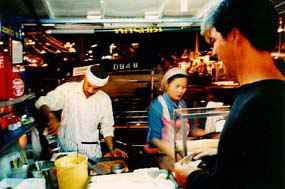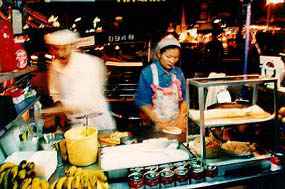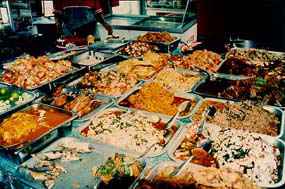Special Feature: Products Sally Recommends
Thailand's Ubiquitous Noodle Stalls
 Although eating off the streets may not be advisable in many countries, sitting down for a bowl of noodles at one of Thailand's ubiquitous noodle stalls is not only safe but also a culinary delight. In Thailand, the place of noodles, or kuay teow, and the vendors who transform them into culinary works of art, is profound. To say kuay teow is merely a "bowl of noodles" is to seriously understate its marvelous qualities and place in Thai society.
Although eating off the streets may not be advisable in many countries, sitting down for a bowl of noodles at one of Thailand's ubiquitous noodle stalls is not only safe but also a culinary delight. In Thailand, the place of noodles, or kuay teow, and the vendors who transform them into culinary works of art, is profound. To say kuay teow is merely a "bowl of noodles" is to seriously understate its marvelous qualities and place in Thai society.
For Thais, the mere mention of noodles has been known to turn heads, perk up ears, and evoke emotional conversations. The quest for the perfect bowl of noodles has driven many to ferret out a recommended noodle vendor in a remote corner of town. It has been said that Thais have abandoned lavish parties and buffets of smoked salmon and caviar to travel absurd distances for the seductive creations of some new noodle vendor.
Many noodle vendors are celebrated for their broths; the ingredients shared only with the vendor's family members. A vendor possessing a culinary angle to the perfect bowl of noodles can expect word to travel fast. Several years ago, a rumor circulated around Bangkok that a particular noodle vendor was dosing his soup with aphrodisiacs, whose miraculous effects were being celebrated by all who consumed it. The chef was an overnight sensation, amassing a quick fortune, but was soon driven into bankruptcy when he, and his noodles, were declared fraudulous.
The Street Dining Experience
Food stalls are portable restaurants and common institutions found in all corners of the Kingdom of Thailand. Food stalls are found in long rows at night markets, in small clusters at busy intersections in Bangkok, and dotted here and there among the bustling shopping districts of both small and large cities. Street stall dining provides a delicious and cheap way to experience a beloved custom unique among the Thais.
 Striking is the democratic tone of the street stall dining experience. Meals are priced so cheap that even the poor afford a bowl of noodles. It is not uncommon to find businessmen in suits dining beside the very poor at plastic tables around a vendor's stall.
Striking is the democratic tone of the street stall dining experience. Meals are priced so cheap that even the poor afford a bowl of noodles. It is not uncommon to find businessmen in suits dining beside the very poor at plastic tables around a vendor's stall.
The street stall experience speaks to the Thai's obsession with food and its importance in daily life. Because the Thais have liberated food from the western staightjacket of breakfast, lunch and dinner, they snack constantly throughout the day. Stalls with beautifully carved fruit provide a quick bite and relief from the afternoon heat. Charcoal-grilled skewers of chicken make a delicious midday snack. Large pots of steaming curry, a bowl of noodle soup, and mango slices with sticky rice and coconut milk, all selected from different vendors, provide a custom-made feast at day's end.
The Noodle Vendor
Whether it's noodle soup prepared in a flavorful broth, or crispy stir-fried noodles served with curry, a trip to Thailand would not be complete without several samplings of noodle-based dishes.
The Thai noodle stall is typically a pushcart, equipped with a charcoal stove, a large pot of steaming broth, and several ingredients, from shrimp to cilanro to scallions, spread across an adjoining counter. A noodle vendor works with a few types of noodles, and prepares them in variety of ways.
As with all street vendors, who do not have to pay rent and other types of overhead, noodle dishes can be had quite cheaply. For as little as $2 US dollars, hungry travelers can buy a filling and delicious meal while enjoying a convivial street stall atmosphere that is a natural part of the Thai lifestyle.
The most common form of noodles used in Thailand are made with rice. They are made by soaking plain rice in water for several hours and then molding the mixture into flat pancakes. The square discs of dough are cut into either thin noodles (sen lek), thick noodles (sen mee), or very thin vermicelli (sen mee) also called rice-stick noodles.
Wheat noodles (bah mee) are made with fresh wheat flour and moistened with eggs. Also called "yellow" or "egg" noodles, bah mee is popular in the north.
Mung bean noodles (wun sen) take the form of cellophane or glass noodles. These noodles are formed from a puree mung beans and water, which is strained to produce a clear liquid. The liquid is then dried into sheets or extruded to form "bean thread" noodles.
How To Order
At most noodle stalls menus are in Thai and vendors speak little if any English. This means that attaining "made to order" noodle creations, especially for travelers who do not speak any Thai, involves some experimentation. Because diners must indicate the type of noodle desired, additional ingredients, and style of preparation, the noodle experience can be a challenging and fun way to order a meal.

Sometimes the name of dish will indicate contents; other times it will refer to a famous style from a particular location in Thailand. Some typical Thai noodle dishes are Pad Thai (vermicelli noodles with small shrimp, bean sprouts, and fish sauce), kuay teow rad nar (stir fried noodles combined with pork, broccoli and oyster sauce), or several variations of stir fried noodles with spicy beef, chicken pork and curries.
Examples of noodle combinations include: noodle soup, wide noodles, pork, broth (kuay teow, sen yai, mu, nam); noodle soup, egg noodles, chicken, no broth (kuay teow, bah mee, gai, haeng), or noodle soup, thin noodles, meatballs, broth (kuay teow, sen yek, luchin, nam).
Travelers can point to the case to indicate the desired choices, or point to the tables of other diners. After a few noodle experiences, the observant traveler will begin to pick up a "noodle vocabulary" and should get better at ordering the types and styles of dishes he or she prefers. Once in possession of their noodles, diners find an array of condiments, from ground chilies, cilantro, to fish sauce, to adjust the noodles to personal tastes.
With so many choices among noodle stalls in Thailand, the only challenge is deciding on the best. Noodle vendors can be found on street corners, in alleys, along rivers, at markets, and in canoes along canals and at popular floating markets. A good rule of thumb for choosing among street stalls is to find those frequented by Thais. Thai diners usually have good taste and their presence at a particular stall is often an indication that it is worth a try. But whatever you do, try noodles -- a national dish that has been called by some "the fuel that drives the engines of a kingdom."
Note: This information was accurate when it was published. Please be sure to confirm all rates and details directly with the businesses in question before making your plans.



